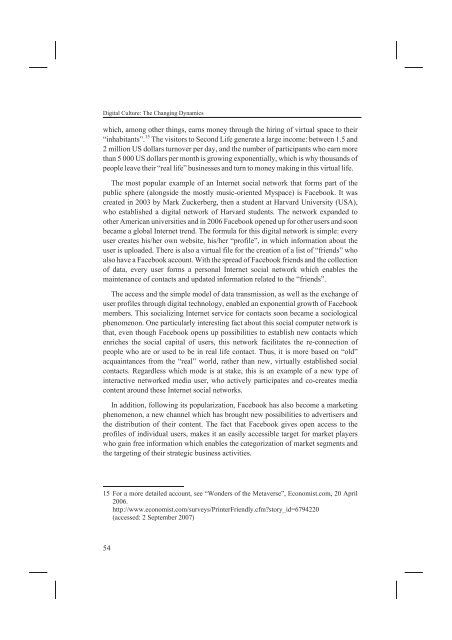D:\Documents and Settings\Ana\My Documents\Biserka-knjiga ...
D:\Documents and Settings\Ana\My Documents\Biserka-knjiga ...
D:\Documents and Settings\Ana\My Documents\Biserka-knjiga ...
Create successful ePaper yourself
Turn your PDF publications into a flip-book with our unique Google optimized e-Paper software.
Digital Culture: The Changing Dynamics<br />
which, among other things, earns money through the hiring of virtual space to their<br />
“inhabitants”. 15 The visitors to Second Life generate a large income: between 1.5 <strong>and</strong><br />
2 million US dollars turnover per day, <strong>and</strong> the number of participants who earn more<br />
than 5 000 US dollars per month is growing exponentially, which is why thous<strong>and</strong>s of<br />
people leave their “real life” businesses <strong>and</strong> turn to money making in this virtual life.<br />
The most popular example of an Internet social network that forms part of the<br />
public sphere (alongside the mostly music-oriented Myspace) is Facebook. It was<br />
created in 2003 by Mark Zuckerberg, then a student at Harvard University (USA),<br />
who established a digital network of Harvard students. The network exp<strong>and</strong>ed to<br />
other American universities <strong>and</strong> in 2006 Facebook opened up for other users <strong>and</strong> soon<br />
became a global Internet trend. The formula for this digital network is simple: every<br />
user creates his/her own website, his/her “profile”, in which information about the<br />
user is uploaded. There is also a virtual file for the creation of a list of “friends” who<br />
also have a Facebook account. With the spread of Facebook friends <strong>and</strong> the collection<br />
of data, every user forms a personal Internet social network which enables the<br />
maintenance of contacts <strong>and</strong> updated information related to the “friends”.<br />
The access <strong>and</strong> the simple model of data transmission, as well as the exchange of<br />
user profiles through digital technology, enabled an exponential growth of Facebook<br />
members. This socializing Internet service for contacts soon became a sociological<br />
phenomenon. One particularly interesting fact about this social computer network is<br />
that, even though Facebook opens up possibilities to establish new contacts which<br />
enriches the social capital of users, this network facilitates the re-connection of<br />
people who are or used to be in real life contact. Thus, it is more based on “old”<br />
acquaintances from the “real” world, rather than new, virtually established social<br />
contacts. Regardless which mode is at stake, this is an example of a new type of<br />
interactive networked media user, who actively participates <strong>and</strong> co-creates media<br />
content around these Internet social networks.<br />
In addition, following its popularization, Facebook has also become a marketing<br />
phenomenon, a new channel which has brought new possibilities to advertisers <strong>and</strong><br />
the distribution of their content. The fact that Facebook gives open access to the<br />
profiles of individual users, makes it an easily accessible target for market players<br />
who gain free information which enables the categorization of market segments <strong>and</strong><br />
the targeting of their strategic business activities.<br />
15 For a more detailed account, see “Wonders of the Metaverse”, Economist.com, 20 April<br />
2006.<br />
http://www.economist.com/surveys/PrinterFriendly.cfm?story_id=6794220<br />
(accessed: 2 September 2007)<br />
54



